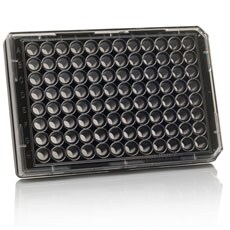Search
Choosing a Vessel for Your Sample

Decide how to contain your cells before you start
There are a multitude of culture and imaging chambers available for cell imaging, but choosing the right one relies on good planning of your experiment before you start. Are you performing multiple treatments? Do the cells require special temperature, atmospheric, or light conditions? What's your microscope configuration?
The information below will help you understand the planning that you need to carry out to ensure that your cells are cultured and contained in a vessel that will allow you to capture the images you need.
Types of vessels available
There are several types of vessels through which you can image. Which one you choose depends on the type of experiment you are doing and the capabilities of your microscope.
Glass-bottom vessels


Multiwell plates

Flasks

Vessel holders and adaptors



Vessel considerations
The type of vessel you use will also depend on your microscope configuration. Here are some of the configuration details you’ll need to consider:
Are you using an inverted or upright microscope?
The type of vessel a microscope can accommodate will partly depend on whether the objectives are below (inverted microscope) or above (upright microscope) the stage (Figure 1).
An upright microscope is good for imaging samples on glass coverslips. This is because the objective can get very close to the coverslip containing the sample. An upright microscope, however is not the best choice for culture dishes and flasks. In these vessels, the cells you want to image are at the bottom of the dish, and a top-mounted objective would have to image through all of the air between it and the sample. Most objectives won’t be able to do this with good results.
Figure 1. The position of your microscope’s objective relative to the sample stage will determine which kinds of vessels will work the best for your imaging experiment.

Will the vessel fit on the microscope stage?
Some stages require an adaptor to fit certain types of vessels. Double check that the microscope you will use has the configuration, holders, or adaptor accessories you need to hold your vessel in place while imaging.
What type of objective will you use?
You will need to use an objective with a working distance that matches the vessel your sample is in (Figure 2).
Are there experimental design considerations?
Sometimes the design of your experiment will limit the vessel type you can use. Here are some examples:
- If you want to look at cells while they are growing in culture, without any manipulation, you will need a microscope configuration that lets you image in a flask or culture dish (such as an inverted microscope with a long–working distance objective).
- Plastic vessels are convenient and widely used for cell culture, but plastics can fluoresce. If this is a problem in your experiment, you may consider culturing your cells in glass-bottom vessels or on glass coverslips.
- If you want to use a mounting medium to preserve your cells after they are stained, it's easiest if the cells are grown on a coverslip.
- If your experiment is testing multiple conditions, it may be easier to set up your experiment in a multiwell plate, so you can have all of your conditions side-by-side in one plate.
Figure 2. Upright microscopes generally work best with samples that are on glass coverslips or slides.

Product Information
Documents
For Research Use Only. Not for use in diagnostic procedures.